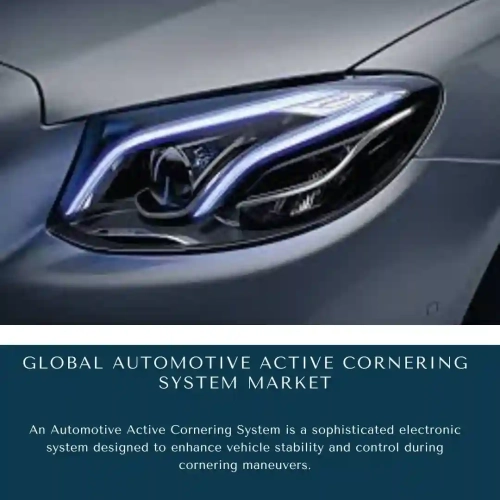
- Get in Touch with Us

Last Updated: Apr 25, 2025 | Study Period: 2024-2030
The Global Automotive Active Cornering System Market is expected to experience significant growth from 2024 to 2030, driven by rising demand for enhanced vehicle dynamics and safety features. This technology allows for individual control of each wheel, improving handling and stability during cornering and challenging maneuvers.
Consumers, particularly those seeking performance-oriented vehicles, are increasingly interested in the improved driving experience offered by active cornering systems. The ability to enjoy heightened control and responsiveness on the road is a major selling point for these systems.
Safety remains a top priority for car manufacturers, and active cornering systems play a crucial role. By independently managing suspension and braking for each wheel, the system can counteract skids and improve overall vehicle stability in critical situations.

The development of autonomous vehicles further fuels the growth of the active cornering system market. This technology provides a foundation for future autonomous driving functionalities, allowing for precise control over vehicle behavior in various conditions.
However, the high cost of active cornering systems remains a hurdle for wider adoption. Integrating this technology adds complexity and expense to vehicle production, potentially limiting its presence in budget-friendly car models.
Despite the cost factor, advancements in technology and manufacturing processes are expected to bring down the cost of active cornering systems in the coming years. This will make the technology more accessible to a broader range of car buyers.
The Asia Pacific region is anticipated to be a major growth driver for the active cornering system market. Rapid economic development and a growing focus on vehicle safety are fueling demand for advanced automotive technologies in this region.
Established automakers are actively investing in research and development to integrate active cornering systems into their premium and high-performance vehicles. This ensures a competitive landscape with continuous refinement of the technology.
Emerging technology firms specializing in vehicle dynamics are also entering the market, offering innovative solutions that emphasize modularity and cost-effectiveness. This fosters healthy competition and drives advancements in the field.
The future of the active cornering system market looks promising, with continuous advancements and increasing demand for enhanced driving experiences and safety features. As the technology matures and costs become more manageable, we can expect to see active cornering systems become a more prevalent feature in cars across all segments.
An Automotive Active Cornering System is a sophisticated electronic system designed to enhance vehicle stability and control during cornering maneuvers. It employs sensors, actuators, and control algorithms to actively adjust the vehicle's suspension and braking systems, thereby minimizing body roll and improving traction through corners.
There are two main types of Automotive Active Cornering Systems: active roll control systems and torque vectoring systems. Active roll control systems use hydraulic actuators or adjustable anti-roll bars to counteract body roll during cornering, while torque vectoring systems vary the torque distribution to individual wheels to optimize traction and minimize understeer or oversteer.
The benefits of Automotive Active Cornering Systems include improved vehicle handling, enhanced safety, and increased driver confidence. By reducing body roll and improving traction, these systems can help prevent accidents caused by loss of control during cornering maneuvers. However, challenges such as system complexity, cost, and integration with other vehicle systems remain significant. Additionally, there are risks associated with over-reliance on electronic aids, which could potentially lead to driver complacency or system failures if not properly calibrated or maintained.

The Global Automotive Active Cornering System Market accounted for $XX Billion in 2023 and is anticipated to reach $XX Billion by 2030, registering a CAGR of XX% from 2024 to 2030.
Continental AGintroduced theContinental's Active Cornering Systemdesigned to enhance vehicle stability and control during cornering maneuvers, ensuring optimal performance and safety. The system utilizes advanced sensor technologies, including radar and camera systems, to detect changes in driving conditions and adjust the vehicle's suspension and braking systems in real-time.
Magna International Inc.introduced theInnovative Active Cornering Systemfor the Global Automotive Active Cornering System Market between 2024 and 2030. Magna's system is engineered to provide superior vehicle stability and control, enhancing driving dynamics and safety. Leveraging state-of-the-art sensor technologies such as LiDAR and advanced control algorithms, Magna's active cornering system continuously monitors driving conditions and adjusts suspension and braking systems accordingly.
ZF Friedrichshafen AGintroduced theAdvanced Active Cornering Systemfor the Global Automotive Active Cornering System Market from 2024 to 2030. ZF's active cornering system is engineered to optimize vehicle dynamics and stability during cornering maneuvers, ensuring precise handling and control. By leveraging cutting-edge sensor technologies and proprietary control algorithms, ZF's system continuously monitors vehicle behavior and road conditions, making real-time adjustments to suspension and braking systems.
| Sr. No | Topic |
| 1 | Market Segmentation |
| 2 | Scope of the Report |
| 3 | Research Methodology |
| 4 | Executive Summary |
| 5 | Introduction |
| 6 | Average B-2-B Selling Price in Past 5 Years |
| 7 | Insights from Industry Stakeholders |
| 8 | Cost Breakdown of Product Components and Average Profit Margin |
| 9 | Disruptive Innovation in the Industry |
| 10 | Technological Innovations in Global Automotive Active Cornering System Market 2024-2030 |
| 11 | Advancements in Sensor Technology |
| 12 | Integration with Autonomous Driving |
| 13 | Software-Driven Solutions |
| 14 | Electrification and Lightweighting |
| 15 | Integration of Advanced Control Algorithms |
| 16 | Development of Adaptive Suspension Systems |
| 17 | Implementation of Artificial Intelligence |
| 18 | Utilization of Predictive Analytics |
| 19 | Integration of Vehicle-to-Vehicle Communication |
| 20 | Development of Real-Time Feedback Systems |
| 21 | New Product Development in the Past 12 Months |
| 22 | Market Size, Dynamics, and Forecast by Geography (2024-2030) |
| 23 | Market Size, Dynamics, and Forecast by Vehicle Type (2024-2030) |
| 24 | Market Size, Dynamics, and Forecast by Drive Type (2024-2030) |
| 25 | Market Size, Dynamics, and Forecast by System Type (2024-2030) |
| 26 | Competitive Landscape and Market Share Analysis |
| 27 | Growth Strategy of Leading Players |
| 28 | Market Share of Vendors (2023) |
| 29 | Company Profiles |
| 30 | Unmet Needs and Opportunities for New Suppliers |
| 31 | Conclusion |